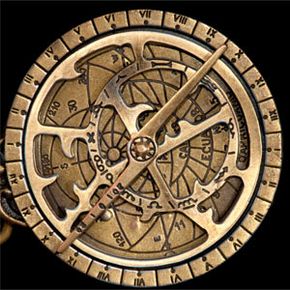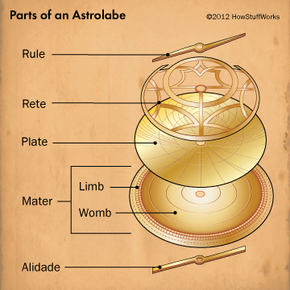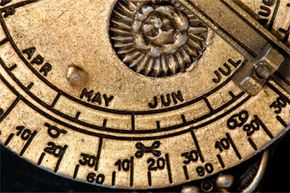If you had an ancient astrolabe in front of you, whether it originated in 11th-century Islam or 16th-century Europe, it would come with the same basic parts. Here they are, working from the bottom of the instrument to the top:
Mater
The mater (Latin for "mother") served as the base of an astrolabe. This circular plate, usually made of brass, stretched about 6 inches (15 centimeters) in diameter and a quarter-inch thick. Its center was hollowed out so one or more plates could sit on top, nestled in the depression.
Limb
The rim of the mater, known as the limb, bore two scales — an inner scale for measuring hours of the day and an outer one for measuring degrees from 0 to 360. A throne bearing a ring sat above the noon marking, defining the top of the astrolabe and providing an attachment point. When he wanted to use the instrument, an astronomer would tie a rope through the ring and let the device hang straight down.
Plates
Next came a series of plates, with each plate corresponding to a specific latitude. This was necessary because an observer located at the equator saw a different section of the night sky compared to an observer, say, at mid-latitude. For the astrolabe to work properly, it needed a plate specific to a given latitude.
Each plate came engraved with two kinds of circles. The first were circles of constant altitude known as almucantars, with the horizon being the most important almucantar. The second were azimuths, which met the almucantars at right angles. The most important azimuth was the meridian.
Rete
The rete (sounds like "treaty") rested on top of the plates. Modern retes are often made of transparent plastic so you can see through them to the plates below. To get the same effect in the ancient world, astrolabe makers cut away large portions of the metal, leaving behind a skeletal-like ring.
The rete was marked with a number of stars and several important constellations. As it rotated around a central pin (the north celestial pole), the rete showed the daily motion of the celestial sphere. The perimeter of the rete contained an outermost scale divided into hours and an innermost scale marked with days of the year.
Rule and Alidade
On some astrolabes, a clocklike hand called the rule, marked with declinations from -30 degrees to +70 degrees, lay on top of everything. A pin passed through the center of the instrument, holding all of the pieces together, but allowing the rule and the rete to rotate over the plate.
The back of the instrument contained a variety of useful scales and tables. All astrolabes included scales for measuring angles and determining the sun's longitude for any date. Many also had scales to solve simple trigonometry problems. An alidade also attached to the back, allowing a user to measure the altitude of a celestial object.


